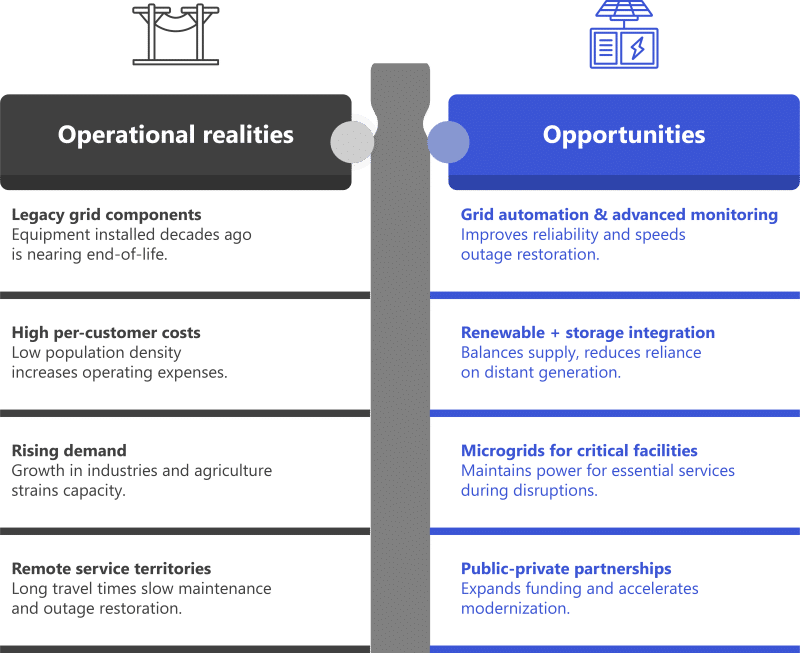8-minute read
Quick summary: Nearly a century after the Rural Electrification Act transformed rural America, utilities face a new challenge: modernizing rural infrastructure to meet rising demand while ensuring reliable, affordable, and sustainable power for the communities they serve.
For rural electricity providers in the United States, the story of the Rural Electrification Act (REA) is more than a milestone in history—it’s a reminder of how coordinated investment and innovation can transform entire communities. Nearly a century after the REA’s launch, rural America faces a new inflection point. Demand for electricity is rising due to the expanded use of electric vehicles, electrified agricultural equipment, and energy-intensive commercial operations. At the same time, utilities must manage aging infrastructure, meet higher reliability expectations, and integrate new technologies, often across vast, sparsely populated territories.
For utility leadership, the question is no longer how to connect rural customers to the grid, but how to ensure those connections deliver reliable, affordable, and sustainable power for decades to come. Achieving this goal requires balancing modernization investments with cost control, leveraging federal and state programs effectively, and identifying technology solutions that deliver both operational efficiency and customer value.
In this article, we explore how rural electrification in the United States has evolved, the challenges utilities face today, and the strategies that can help decision makers position their organizations—and the communities they serve—for the future of energy.
Historical context of rural electrification
When Congress passed the Rural Electrification Act (REA) in 1936, it addressed a problem private utilities had deemed economically unsolvable—bringing power to rural America. At the time, low population density, long distances between customers, and limited industrial demand made the business case unworkable. The REA changed the equation by providing low-interest loans and technical guidance to community-based electric cooperatives, enabling them to build and operate local distribution systems.
The REA’s success demonstrated the impact of targeted investment, innovative delivery models, and strong stakeholder engagement—principles that remain highly relevant to utilities today. As rural America approaches a new era of transformation, these same levers can help balance infrastructure expansion with long-term operational sustainability.
Role of the Rural Electrification Administration
Following its formalization in 1936, the Rural Electrification Administration (REA) became the central driver of rural electrification. In addition to providing low-interest loans, the agency offered engineering expertise, established construction standards, and delivered training to ensure electric systems were safe, reliable, and built for longevity.
By introducing standardized pole designs, wire specifications, and installation practices, the REA helped electric cooperatives reduce costs and accelerate construction without sacrificing quality. Its loan programs gave community-based, member-owned cooperatives the means to build and maintain distribution networks, with governance structures that kept decision making close to those served.
As rural electrification neared completion, the REA shifted toward maintaining and modernizing infrastructure. In 1994, it became part of the U.S. Department of Agriculture’s Rural Utilities Service (RUS), which now also supports water, wastewater, and broadband infrastructure. The RUS continues to provide financial and technical resources that enable rural communities to adapt utility systems for a more connected, resilient, and sustainable future.
Progress made—and remaining challenges—in rural electrification
Rural electrification is widely regarded as one of the nation’s most successful infrastructure initiatives. Electric cooperatives—many formed during the REA era—continue to serve large portions of rural America, supplying power to tens of millions of residents and maintaining networks that span some of the country’s most geographically challenging terrain.
This infrastructure has supported agricultural modernization, enabled rural manufacturing, strengthened public services, and improved quality of life. Advances such as modern irrigation systems, energy-efficient heating, and digital technologies are now commonplace in areas that once lacked basic electric service.
Challenges persist. Low population density and long service lines raise operating costs per customer, making modernization investments more difficult to fund. Much of the original infrastructure is approaching the end of its service life, increasing the risk of outages, particularly during severe weather events when crews must cover hundreds of miles to restore service.
Affordability remains a concern. A 2024 report from the American Council for an Energy-Efficient Economy (ACEEE) found that rural households face a combined home and transportation energy burden nearly 50 percent higher than that of urban households, with the gap even wider for low-income rural residents.
Operating realities and opportunities in rural areas
Rural utilities operate under conditions that differ sharply from those of their urban counterparts. Vast service territories with low population density mean longer distribution lines, fewer customers per mile, and higher maintenance costs. Many systems still operate with legacy grid components, and replacing components in remote areas can require significant capital outlays.
Economic factors add pressure. Lower average incomes and smaller customer bases make it harder to recover the costs of modernization, which can slow the adoption of advanced technologies such as smart meters, automated outage detection, and distributed energy integration.
Despite these constraints, rural areas have unique opportunities. Technologies such as utility-scale renewables, battery storage, and microgrids are already showing value in rural contexts.
Partnerships and funding support are critical to bridging gaps between immediate needs and long-term goals. Engaging local stakeholders in planning ensures that investments address immediate needs while also supporting long-term economic growth.
Balancing the realities of geography and economics with the potential of new technologies will be essential for rural communities seeking to maintain reliability and position themselves for future growth.

Modernization and expansion of rural infrastructure
Upgrading rural electric systems requires a dual focus: replacing legacy assets to improve reliability and integrating new technologies to enhance efficiency and sustainability. Replacing poles, lines, and substations offers an opportunity to incorporate smarter, more resilient designs that can withstand severe weather and adapt to changing load demands.
Federal and state programs play a critical role in financing these upgrades, from transmission line replacements to renewable generation projects. Investments in grid automation, advanced metering infrastructure, and real-time monitoring can reduce outages, improve operational efficiency, and support compliance with evolving regulatory standards.
Broadband investment
High-speed internet access has become as vital to rural development as electricity was in the early 20th century. Many utilities are using existing infrastructure to deploy broadband, leveraging programs such as the USDA’s ReConnect Program and the FCC’s Rural Digital Opportunity Fund. Running fiber along power lines reduces construction costs while enabling telehealth, online education, remote work, and precision agriculture.
FCC involvement
The Federal Communications Commission (FCC) supports rural broadband through initiatives like the Universal Service Fund and the Connect America Fund, which subsidize providers serving high-cost areas. Coordinating upgrades between energy and telecom sectors—such as sharing pole access—can maximize the impact of infrastructure investments.
Growing demand
Rural systems are experiencing higher load requirements as industries diversify and economic activity grows. Population increases, rural manufacturing, and expanded agricultural production are adding to the strain on infrastructure.
Many utilities are using existing infrastructure to deploy broadband, running fiber along power lines to reduce construction costs while enabling telehealth, online education, remote work, and precision agriculture.
Future directions and sustainability
The next phase of rural electrification will be defined by the ability to maintain affordability and reliability while meeting evolving environmental and economic demands. Strategic planning, supported by targeted investments and community engagement, will be essential to ensuring rural systems remain competitive and resilient.
Distributed renewable generation
Expanding local energy sources—such as community solar arrays, small-scale wind installations, and biogas from agricultural operations—can reduce reliance on distant generation. Coupling these resources with battery storage can help manage variability and strengthen grid stability during peak demand or outages.
Microgrids and resilience planning
Microgrids allow segments of the grid to operate independently during disruptions, ensuring that critical facilities—such as hospitals, emergency services, and schools—remain powered. Integrating renewable generation and storage within these systems can enhance both resilience and sustainability.
Policy and funding alignment
Federal and state programs will continue to be vital in financing modernization and advancing new technologies. Policies that encourage renewable integration, grid hardening, and efficiency improvements can accelerate progress while keeping rates manageable.
Community engagement
Sustainable progress depends on collaboration among utilities, policymakers, and residents. Cooperative governance models, local advisory boards, and open planning processes ensure that modernization priorities reflect community needs and long-term goals.
Expanding local energy sources—such as community solar arrays, small-scale wind installations, and biogas from agricultural operations—can reduce reliance on distant generation.
Frequently asked questions about rural electrification
Which source of energy is best for rural areas?
The optimal source depends on available resources, infrastructure, and demand. Many rural regions benefit from a mix of distributed renewables—such as solar, wind, or biogas—paired with battery storage for reliability. In some areas, hydropower or biomass can provide consistent baseload generation.
How can electricity be generated in rural areas?
Generation can come from both centralized plants and local systems. Options include utility-scale renewables, community solar programs, small modular natural gas units, and microgrids. Local generation can reduce transmission losses and improve resilience during grid disruptions.
What challenges do rural electricity systems face?
Rural systems often contend with higher per-customer costs, slower adoption of advanced technologies, and greater vulnerability to outages caused by severe weather or equipment nearing the end of its service life. Limited capital can also make modernization more difficult.
Powering the next chapter of rural electrification
Rural electrification began as a bold effort to close the gap between rural and urban access to power—and it succeeded. Today, the opportunity lies in building on that legacy to create systems that can adapt to changing technologies, market demands, and environmental realities.
Progress will depend on coordinated investment, sound policy, and strong collaboration among utilities, government, technology providers, and local communities. Strategic initiatives—such as renewable integration, microgrid deployment, and broadband-energy partnerships—can help rural regions strengthen resilience and create new avenues for growth.
The first era of rural electrification proved what’s possible when vision meets action. The next will require the same determination to design systems that not only meet current needs, but also empower communities to thrive for generations.

Powering a sustainable tomorrow
We partner with utilities to help them build a more resilient grid and move towards a cleaner, brighter future through
- AI-driven automation
- Asset image analytics
- DERMS implementation
- Analytics & predictive insights
- Cloud optimization

